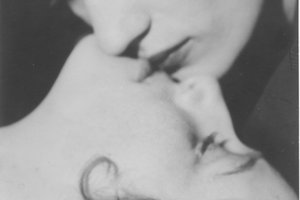“French Twist,” an exhibit of gorgeous French photographs, offers local Francophiles the chance to enjoy Gallic culture without having to travel to Paris.
The traveling exhibit is currently on display at the Delaware Art Museum, 2301 Kentmere Pkwy. in Wilmington, Del. Subtitled “Masterworks of Photography from Atget to Man Ray,” the show contains more than 100 photographs by 18 artists, including acknowledged masters such as André Kertész. It will be on display until Sept. 15.
“French Twist” provides a thorough introduction to the remarkable fecundity of French photography in the first third of the 20th century. Candid snapshots by talented amateurs such as Jacques-Henri Lartigue hang side-by-side with experimental works, and surrealist provocations are given as much space as sober photojournalism. This inclusivity allows viewers to see the breadth of photography that France inspired.
The sheer diversity of the work is partly the result of its time. The turn of the century inspired an optimism that was soon soured by the devastation of World War I. At the same time, technological progress was rapidly transforming society in general and photography in particular. The artists represented in this exhibit were acutely aware of this cultural backdrop, and they used advances in the relatively young medium of photography to represent it.
During the interwar period, Paris was a cultural capital, attracting artists and bohemians. But as “French Twist” amply demonstrates, a lot of the imagery typically associated with French photography, its streetscapes and rural scenes, was actually shot by immigrants. Moreover, some of the most iconic photographs in the exhibit were taken outside France’s borders.
The exhibit’s vibrancy can be found in the contrast between the work of Brassaï and Cartier-Bresson. Brassaï emigrated from Transylvania to Paris, adopted his one-name nom de plume, and quickly immersed himself in the city’s brothels, cafes and opium dens. Cartier-Bresson, on the other hand, was born in a small village just outside the French capital, began his artistic career as a Surrealist, and blossomed into a globe-trotting photojournalist.
Brassaï’s images of the Parisian demimonde convey an immediate sexual frisson. “Street Toughs” depicts two handsome young men identified as members of a criminal gang. Their look is both threatening and enticing. Viewers can’t be entirely sure if these thugs are about to mug someone or if they are offering themselves up for a night of pleasure — at a price, of course.
A series of pictures shot at a saloon, including “Lovers, Bal Musette,” shows working-class men and women seemingly in the midst of tender, romantic moments. According to Brassaï, however, the wateringhole was a seedy dive where pimps forced women into prostitution.
In comparison, Cartier-Bresson’s vision is more humane and encompasses a wider range of subjects than that of his contemporary. Working in Spain shortly before its civil war, he captured gritty, moving images of the poor, and yet his beautiful 1933 image known as “Italy” portrays a nude man and woman with all the detail of a classical sculpture.
Cartier-Bresson’s surrealist roots never disappear entirely. In his 1937 photograph “Coronation of King George VI,” the artist turns his camera away from the ceremony and towards the spectators. The resulting image is just as unexpected and startling as his earlier work, “Allée du Prado,” where a pedestrian he had been following turned suddenly and met his gaze. Fortunately, the artist’s camera was at the ready, and he captured this “decisive moment,” as he called it.
Another attractive feature of “French Twist” is the generous sampling of artwork by women, who were just as likely to be snapping photos as they were to be modeling for them.
Ilse Bing’s photographs of Parisian street scenes convey the hustle and bustle of urban life, often just by showing a city sidewalk or an ad posted on the side of a building. Known as the “Queen of the Leica,” this German-Jewish émigré shot many photos in between assignments for fashion magazines and newspapers.
Also noteworthy are the photographs of Dora Maar. Her images of street scenes are far from pedestrian. Somehow, with crystalline clarity, she captured images of breathtaking absurdity that epitomize the Surrealist project. In the photograph “L’Orangerie,” she achieves a striking effect simply by taking a straightforward image of an architectural detail and displaying it upside-down.
The curious are encouraged to check it out for themselves. The Delaware Art Museum is open Wednesday through Sunday, and admission on Sundays is free. On Sept. 6, the sexy models of Dr. Sketchy’s Anti-Art School will lounge about in period costumes looking louche — just in case you’d like to whip out your sketchbook and draw them.
For more information, visit www.delart.org/.
